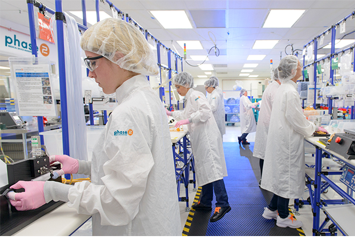Focus on measuring and improving these 3 metrics and your production operators will generate a more consistent and predictable output

The phrase “work smarter, not harder” was coined by Allen F. Morgenstern in the 1930s. It can be applied to any work situation, but on a manual assembly line, there is an abundance of opportunities to put this mantra into practice, and to realise new levels of productivity.
If you need to boost productivity by 10-20%, asking people to work 10-20% faster is not the answer; firstly it’s not sustainable and secondly, it usually leads to a drop in quality standards. Instead, focus on monitoring and improving the following three metrics and you will achieve more stable and predictable output numbers and a happier workforce.
Availability
Availability is a measure of how much of the scheduled shift time that production operators spend manufacturing products. In many cases, it is surprisingly low. When you add up all of the stoppages, from the small 1-5 minute interruptions through to the 30 minute+ shutdowns, each production operator on an assembly line or cell typically only builds product for 40 to 70% of their shift. The rest of the time is spent waiting for machines and fixtures to get repaired, waiting for materials, doing paperwork, counting products, labelling rejects, etc, etc.
Is this constant flood of disruptions frustrating? Of course. Imagine if your laptop stopped working every 15 minutes, just when you’re getting into a rhythm.
Are many of the stoppages avoidable? Absolutely. Concentrate on the following and you will start to recover much of the lost time and give the operators more time to hit their targets…
- Quantify all of the planned and unplanned stoppages, no matter how small
- Measure how long changeovers take
- Put an escalation process in place to reduce the impact of stoppages
- Pick a project every quarter that focuses on reducing the impact of a big downtime issue
The Kt-Pulse app enables production operators to quickly and easily log downtime and changeover events at any manual or semi-automated manufacturing process. It’s very accurate and the analytics instantly flag where resources should focus, to minimise the impact of downtime issues.
Performance
Performance is a measure of how well production operators can meet the planned output, when the line or cell is running. Targets should be based on the customer demand, but it’s important to balance the work content across all of the workstations so that production operators can consistently achieve the planned output.
A timing study is a useful way to determine how much of the work content that each workstation can comfortably manage. But don’t use the fastest operator on the line to time each workstation. Instead, the timing study data should be based on the average or median time to build a unit, based on a qualified worker, without over exertion, provided they adhere to the specified method and are motivated to apply themselves. This will set you up for more predictable output numbers, regardless of who is located at each workstation on the line. It also sets a realistic expectation for the production operators to achieve.
Here are some tips when setting up lines or cells to achieve more predictable, consistent output…
- Communicate hourly targets to the operators and teach them how to track output accurately
- Implement standard work so that all operators follow the same sequence of steps consistently
- Introduce fixtures/production aids where processes require high dexterity or guesswork
- Rotate production operators, ideally every 2 hours, to keep everybody motivated
- Manage the constraint step closely; if the constraint step requires a high level of speed and dexterity, then simplify the process as much as possible. Understand which operators are capable of running the constraint step consistently and develop a cross training plan to avoid over reliance on one or two individuals.
The Kt-Pulse app enables production operators to quickly and easily log output in real-time at any manual or semi-automated manufacturing process. The analytics clearly show if output is on track in real-time, and motivates production operators to hit planned output much more consistently.
Quality
Process Quality is a measure of how frequently a production operator can produce a product at the first attempt. If a product is defective it may be scrapped or reworked. It is justifiable to rework a unit rather than bin it when the cost of rework is low compared to the cost of building a replacement product.
When resolving scrap or rework issues, sometime it’s a case of simply changing a work practice or putting a poke yoke fixture in place to prevent an error from occurring. Other times, it is more complex to solve and a small team is put in place to follow a structured problem solving process. This will help to understand the problem and to root cause it more easily. Once the root cause is known, the solution is normally straight forward to implement.
Here are some useful guidelines when the quality level of your manual or semi-automated processes needs to improve…
- Understand defects or rework properly by tracking quantity, reason codes and where they occur
- Train the operators to flag unusual levels of defects or rework early
- Put poke yoke solutions in place to prevent defects or rework from happening
- Include production operators in problem solving investigations; they are a wealth of information
The Kt-Pulse app enables production operators to quickly and easily log defects and rework in real-time at any manual or semi-automated manufacturing process. It tells you precisely when and where the defects and rework are occurring, which is very powerful data for problem solving investigations.
Request a free demo
If you’d like to see for yourself how Kyzentree’s software, Kt-Pulse, can help you to monitor and improve your manual processes, book a one-to-one, no obligation consultation today and we’ll showcase the benefits to you

Anthony Cahill has over twenty years’ experience in various roles within the manufacturing sector. He has primarily worked in manufacturing operations that rely on people working with their hands, fixtures and semi-automated equipment to produce discrete goods across a range of industry types. With a background in lean manufacturing and six sigma principles, he has a passion for looking at challenging manufacturing environments and working with cross-functional teams to transform them into safer and more efficient work spaces for all concerned.
